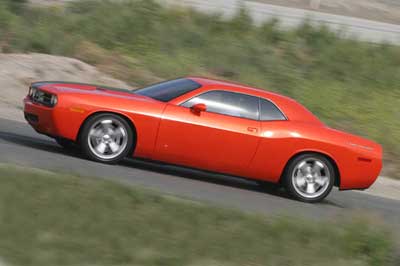Recent Articles
Popular Makes
Body Types
Dodge Challenger Concept First Drive
Behind the wheel of the latest concept in American muscle
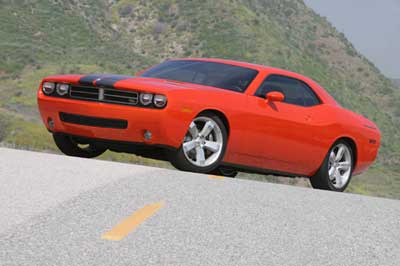
SAN BERNARDINO, Calif. – Smoke pours from the Dodge Challenger Concept’s rear wheels after dumping the clutch at 5,000 rpm and matting the accelerator to the floor. The tail slews until we speed-shift into second, and another stab at the throttle results in another set of thick, black stripes on the pavement as the Challenger picks up speed and rips past 60 mph before the upshift to third. Now we’re rocketing toward triple digits, the functional butterfly-valve intakes scooping desert air into the humongous Hemi V8, the exhaust roaring beneath us, the landscape blurring, Gotcha. We drove the Dodge Challenger Concept car that wowed the crowds at the 2006 North American International Auto Show in Detroit this year, and which also appeared in illicit nudie photos after a young lady sneaked into Cobo Hall late one January night, but not the way in which admirers of the vehicle fantasize. All that’s true about the opening paragraph is that the butterfly-valve intakes inside the classic performance hood’s twin scoops are functional, that the Challenger Concept has a humungous Hemi V8 engine under the hood, that the car is painted a bright hue called Orange Pearl, and that we were in the desert. The rest, well, we can only dream along with you. Driving a concept car is not like driving a production car, making any observations about the experience irrelevant to what might actually roll out of a factory in the future. The Dodge Challenger Concept is a one-of-a-kind vehicle, valued at more than $1 million. It has no Vehicle Identification Number (VIN), and cannot be driven legally on public roads. The Challenger is hand built, and while the running gear works, it’s about as reliable and refined as that Baja Bug your uncle built in his garage back when he was a pot-smoking, war-protesting hippie. During our drive, Dodge asked us to keep speeds below 40 mph, to close the doors with care, and not to make sharp turns. Most of the Challenger Concept’s interior features are for show and not go, so the driver’s seat offers minimal adjustment, the gauges don’t work, the air conditioning is an idea rather than a reality, and the exhaust system fills the cabin with life-shortening fumes. Good thing the power windows worked, one at a time and at a snail’s pace. Nevertheless, it was a treat to accelerate the Challenger for the cameras, even if the engine stalled approaching every other three-point turn. Dodge is working on a business case for building the car, a car that, if we dare extrapolate from our short time behind the wheel in a controlled environment, would sell quite well right out of the gate unless fuel prices double again. In production form, the Challenger would be equipped with Chrysler’s Street and Racing Technology go-fast goodies in top trim, and if the concept car’s seats and interior were literally translated for the assembly line, this would be an immensely satisfying take on the modern muscle car. Especially if it’s able to re-pave roadways in the first three gears.
Design Brief
When designers at Chrysler Group’s West Coast Pacifica Studio sat down to brainstorm what a Dodge Challenger for the 21st century should be, they sketched out a list of attributes that should define a modern muscle car:
Starting with a shortened version of the rear-drive LX platform that serves as the foundation for the Chrysler 300, Dodge Charger, and Dodge Magnum, stylists began work on the Challenger. An original 1970 model was brought into the studio to serve as inspiration for the concept car, chosen because the ‘70 is the most sought-after model by collectors. Chrysler’s hired pens didn’t want to re-create that car, though. Rather, they wanted to create the Challenger that most people see in their mind’s eye – a car without imperfections like the original model’s tucked-under wheels, long front overhang, and poor build quality. The new Challenger needed to replicate all the good things about the original car, but in an updated form to erase all the bad things. I asked Michael Castiglione, the Challenger Concept’s principal exterior designer, why they didn’t bring in the second-generation Challenger, a rusted-out 1978 complete with Mitsubishi running gear, as further inspiration for the team. Maybe as a reminder of what to do. Castiglione clearly wondered what kind of moron he was dealing with.
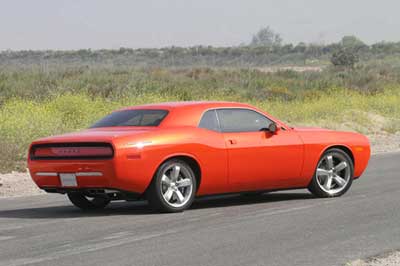
Exterior Design
To capture the flavor of the original Challenger, Dodge designers focused on the basics: body shape, critical styling elements, and proportions. A true four-passenger car, the Challenger Concept retains the general profile of the 1970 model, but is equipped with a more rakish windshield, a faster backlight, smaller side windows, and a longer greenhouse. All of the glass is mounted flush to the body without moldings, and the belt line ramps up sharply at the rear quarter windows like the original. The Challenger Concept is also a genuine hardtop without a B-pillar, as it was in the good old days. Sitting on a 116-inch wheelbase that is six inches longer than the original, the Challenger Concept is also two inches broader than the 1970 edition and is endowed with a wider track, making the concept’s proportions just right despite the growth in key measurements. The Challenger’s thrust line, the signature side-view accent line that usually marks the widest part of the body, sits higher than it did 35 years ago, yet evokes exactly the same flavor on this larger concept machine. Designers also wanted to preserve the ultra-wide appearance of the first Challenger, so the front overhang was increased on the concept car to create a satisfactorily long, low, and broad hood. Car-width “cavities” front and rear mimic the look of the original and sculpted wheel wells recall the bulging lips of the classic Challenger. Though the concept rides on 20-inch front and 21-inch rear wheels* that sit flush with the body sides – a huge departure from the 1970 model’s skinny little tucked-under rims and tires – the result works to brilliant effect. Also, the concept has flush-mounted, body-color bumpers, but you hardly notice them. In fact, some people might have trouble telling the difference between the old car and the new one. That’s because the devil is in the details, the things that instantly recall the flavor of the first Challenger even though they are entirely modern elements. In front, there’s the signature Dodge cross-hair grille, flanked by four round headlamps recessed into that car-wide front cavity. Look closer, and see that the inner lights are “six-shooter” style. The car-wide motif is repeated at the rear, where a single neon-illuminated taillight lens punctuated with DODGE block lettering spans the Challenger Concept from side to side, underscored by reverse lights flanking the license plate cutout in the fascia. Quad rectangular exhaust outlets, slim rectangular side marker lamps, circular turn signal indicators in front, and the classic “R/T” badge in the grille are all patterned after the look of the original. Even the scalloped door handles and the performance hood with its functional butterfly-valve intakes are knock-offs with a modern twist – that hood is carbon-fiber, and those stripes are the unpainted portion. Exterior details that did not make the final cut on the Challenger Concept included a racing-style gas cap, hood tie-down pins, a louvered rear window, and bold bodyside stripes. I asked Castiglione if the Pacifica design team had considered creating the Challenger in the mold of the original SE model, complete with a white padded vinyl roof and fake wire wheel covers. Again, he clearly wondered what kind of idiot he was dealing with. * Some photos of the Dodge Challenger Concept in this article show 20-inch wheels from a Dodge Magnum SRT-8, which were installed for test drives.
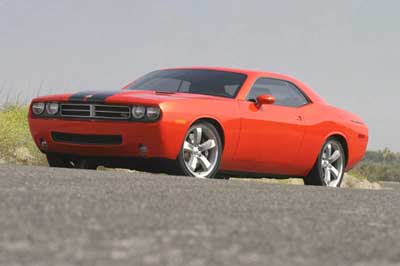
Interior Design
Alan Barrington was the principal interior designer for the Dodge Challenger Concept, and as with the exterior, he says the goal for the cabin was to capture the memory of the original model, but express it through contemporary materials, textures, and surfaces. Thus, the interior is no-nonsense black, with satin silver accents and thin orange bands on the seat backrests. Unlike the old-school Challenger, which came equipped with board-flat seats good for nothing but traveling in a straight line, this Challenger Concept gets SRT-style seating, properly bolstered to hold you still in corners. They are, however, pleated with 1970s-style ribs for a proper retro look and feel. The Dodge Challenger Concept’s instrument panel sits high like the original car, and a trapezoidal gauge cluster houses three analog gauges and a computerized telemetry display. The analog gauges include a speedometer, a tachometer, and a multi-function gauge showing engine temperature, oil pressure, voltage, and fuel level. The telemetry display is obviously an outgrowth of video games, and relays information about top speed, quarter-mile time and speed, and top speed for each gear. Barrington says he wanted the gauge cluster to resemble the look of cylinders when viewed from above with the engine head removed. I thought they looked like gauges. Other interior details made me instantly remember the original Challenger. For example, the steering wheel is designed to look like original car’s three-spoke “Tuff” wheel, including the dust-trapping ribbed steering column. However, the concept car’s wheel, unlike the original’s, has modern, integrated cruise control switches. The floor console is angled toward the driver like the original Challenger, and is equipped with a pistol-grip shifter that feels good in the hand. But this is a six-between-the-seats, not a four-on-the-floor, another reminder that the Challenger Concept’s hardware is high-tech, not yester-tech. Here’s a trivia question: Did you know that the 1970 Dodge Challenger was the first car to get injection-molded door trim panels, which is now a common manufacturing practice? The Challenger Concept is no different, and the doors have a coved armrest decorated with silver trim and equipped with four power window switches on the driver’s side. Silver trim also highlights the stylish center panel on the dashboard, where the integrated stereo and climate controls are located. Under those two commonly used features, a row of toggle switches for the seat heaters, fog lights, hazard flasher, and stability control system are recessed forward of the shifter. Of course, all this stuff is theoretical, just for show. But if the Challenger ever makes production, these features are certain to be included. I asked Barrington if he had considered installing an eight-track tape player in the Challenger Concept to, y’know, make the car “period correct.” He clearly wondered what kind of goofball he was dealing with.
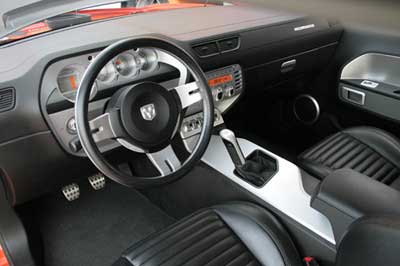
Nuts and Bolts
Remember what the design team identified as one of the top five attributes of a modern muscle car? Horsepower, and lots of it. That’s why the 6.1-liter Hemi V8 from the SRT family is installed under the Dodge Challenger Concept’s carbon-fiber hood, making 425 galloping ponies at 6,000 rpm and 420 lb.-ft. of torque at 4,800 rpm. If that doesn’t impress you now that Ford claims a 500-horsepower rating for its new Shelby Cobra GT500, rest assured that Chrysler won’t let the Challenger come to market without a competitive engine. I mean, that would wreak havoc on the business case, wouldn’t it? A six-speed manual transmission sends the power to the rear wheels, making this the only car on the planet – that we know of – equipped with a 6.1-liter Hemi and a manual. No wonder it’s worth a cool mil, eh? A four-wheel short- and long-arm independent suspension keeps the wheels on the ground, wheels that wear P225/40R20 rubber up front and P265/45R21 treads in back. If the dummy toggle switch on the dashboard is any indication, a production version of the Challenger would be equipped with electronic stability control that could be defeated for smoky burnouts. We would also expect four-wheel-disc brakes with electronic brake-force distribution and some kind of brake assist technology. After our driving and filming was complete, I interviewed Sam Locricchio (lo-creek-ee-o), whose title is ridiculously long so I’ll refer to him as “head PR dude.” I asked Locricchio what the next cool concept car from Chrysler might be, especially now that fuel economy and gas prices are at the top of every consumer’s mind. Might we see a thrifty Dodge Omni, or maybe a spiffy Shadow America next? He clearly wondered what kind of imbecile he was dealing with.
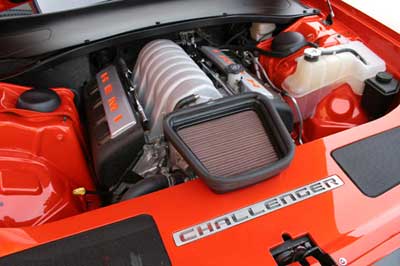
Specifications
Test Vehicle: Dodge Challenger Concept Price of Test Vehicle: $1,000,000+ Engine Size and Type: 6.1-liter Hemi V8 Engine Horsepower: 425 at 6,000 rpm Engine Torque: 420 lb.-ft. at 4,800 rpm Transmission: Six-speed manual Observed Fuel Economy: Not good, that’s fer damn sure Length: 197.8 inches Width: 78.6 inches Wheelbase: 116.0 inches Height: 57.0 inches Max. Seating Capacity: Four Max. Cargo Volume: Not bad, considering Competitors: Audi S4, BMW M3, Cadillac CTS-V, Chevrolet Camaro Concept, Ford Mustang Shelby Cobra GT500, Honda Insight, Mercedes-Benz CLK65 AMG, Nissan GT-R, Porsche Cayman S
Photos by Ron Perry
